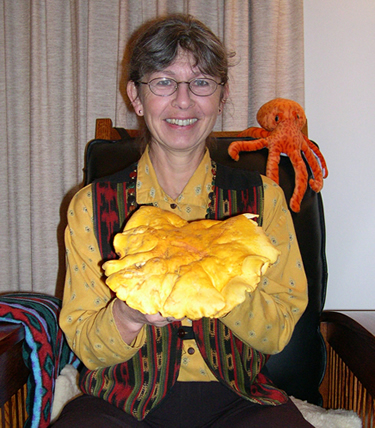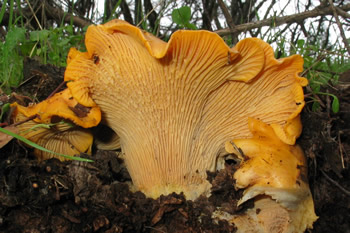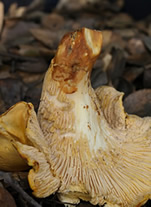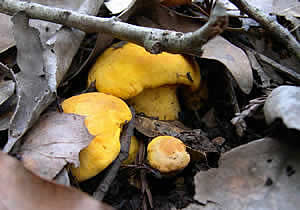Cantharellus californicus: California's Giant, Oak-Loving Golden Chanterelle
The phrase "the golden hills of California" evokes an image of hills of golden grass, rippling in the wind. But to a mushroom hunter in our verdant, winter rainy season, it can mean something quite different. Greet a new kind of gold: the giant, California golden chanterelle, Cantharellus californicus. Newly described by David Arora and Susie Dunham in 2008, this monster chanterelle, the largest in the world, has impressed and fed local pot hunters for generations. Formerly lumped under the catch-all name of Cantharellus cibarius, just one of these golden beauties can feed a family of four — with leftovers!

California chanterelle, modeled by Cathy Aubron
© photo by Debbie Viess
California golden chanterelles grow from the ground in a symbiotic, mycorrhizal partnership with live oak trees. Their fluted forms stud the sun-dappled oak duff with splashes of gold, and can often be thickly buried beneath it. Chanterelles have an overall golden orange color, shallow gill ridges instead of deep true gills and white inner flesh. They sometimes show an orange-red staining or bruising or even a type of rot with age and handling. The exact nature of this color change has not been determined, but it should be completely trimmed off before eating the chanterelle.

Chanterelle glamour shot © Hugh Smith
California oak chanterelles dwarf the competition due to their ongoing growth in the field, a phenomenon referred to as "indeterminate growth." Most mushrooms, and even most chanterelles, produce a short-lived fruit body with a spore-bearing surface, shed their spores, and then rot away. Cantharellus californicus continues to add fertile layers atop the old — producing spores over a period of weeks or months rather than days, and growing ever larger and more complex in shape over time.
Fall and winter is the most productive season for chanterelles, but they can appear through the spring and even in the summer in areas of coastal fog drip. Early rains can stimulate the mushroom mycelia to form numerous primordia, knots of tissue representing chanterelles in miniature. Under the right conditions, these primordia become full blown chanterelles with the addition of time and more water. As local mushrooms hunters are well aware, the conditions for the 2009/2010 mushroom season have been ideal, and the fungal results spectacular.
We may love to eat these massive mushrooms, but other animals, including common fungus devouring insects, seem to eschew them. Strikingly unlike the well-wormed chanterelles from other parts of the country, mushroom maggots are never a problem with these California chanterelles. I have on rare occasions observed a type of millipede in holes on chanterelles, but I suspect that these insect predators are just using the mushroom as hunting habitat and shelter. Even snails and slugs don’t seem to care for the taste of chanterelles.
It’s not just the creepy crawlies in our woods that disdain them. I have never seen evidence of squirrel nibbles on a chanterelle (like we commonly see with Boletus edulis and matsutake) or deer dining or even foraging by the otherwise omnivorous, omnipresent feral pigs. Pig trails can pass right by chanterelle patches, but they leave the mushrooms unbitten, although often trampled or rooted in passing. Pigs do eat many other edible mushrooms, including grisettes and mild flavored russulas.
I guess that just leaves more for us!

"red rot" on a chanterelle
The biggest downside to the California giant chanterelle is its sometimes muddy surface and sodden texture. It can be hard to stay clean and dry when you are out in the field for months on end! Although you may have been cautioned to never wash your mushrooms, unless you enjoy the taste of dirt, you will definitely want to wash these. In fact, these "mud-puppies," as some hunters affectionately call them, are so robust that they can stand up to a good hosing, as long as you keep it to a gentle spray. It is then best to allow them to air-dry for a day or so in a cool place. Once clean and dry, they can be stored for weeks in a refrigerator, in sealed Tupperware containers lined with paper towels. They can also be prepped and lightly sautéed and then frozen for use at another time. Drying is not recommended due to the resultant leathery texture. For more information about preparation, storage and cooking, see our page in the recipe section.
 |
 |
| Omphalotus olivascens © Deb Dreschler | Hygrophoropsis aurantiaca |
California golden chanterelles have one notable toxic lookalike, the “Jack ‘O Lantern Mushroom,” Omphalotus olivascens. This seriously toxic species grows on dead wood (which may be buried in the ground), has deep, true gills with a greenish cast, and orange rather than white inner flesh. The false chanterelle, Hygrophoropsis aurantiaca, is another chanterelle lookalike, but one more likely to produce disappointment than illness. New hunters, desperate to find an edible wild mushroom, have mistaken these common, orange mushrooms for chanterelles in the field. Their somewhat brownish caps, soft, fragile flesh and true gills, that fork at the caps edge, separate them from their Cantharellus counterparts.

Young, small, round-capped chanterelles
This has been a stupendous year for these excellent and popular edible mushrooms. Look for them under coast live oak around the Bay Area and beyond, wherever live oak and winter rains coincide. But remember, not every year is like this one. It takes a lot of energy, from both tree and fungus, to produce a massive fungal fruiting, so don’t expect another one of its like for a while. If a known “chanterelle oak” doesn’t produce chanterelles again next year, be patient — when conditions are right they will appear, as if by magic, and our California hills will once again run with gold: the eating kind.
© Debbie Viess 2/1/2015
Note: In 2023, Cantharellus californicus was voted the California official state mushroom. Bay Nature Magazine ran an updated version of this page in January 2024.. Click here to view the article.

 back to top
back to top